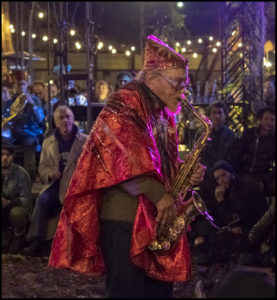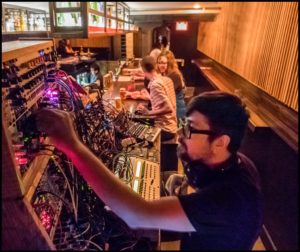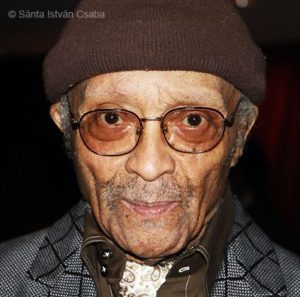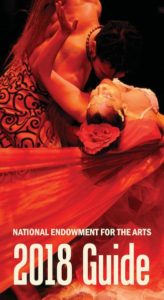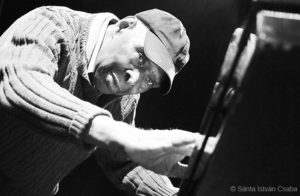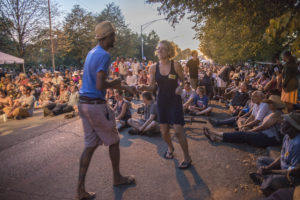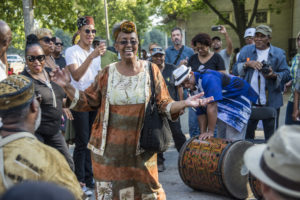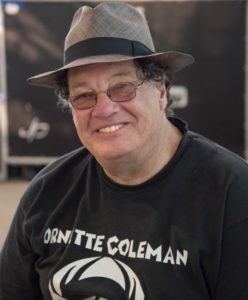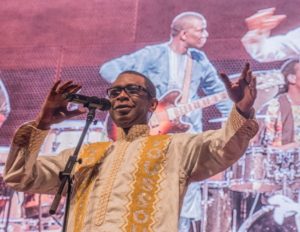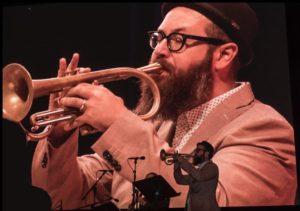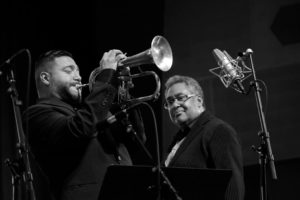Keyboardist and synthesizer specialist Jim Baker has led the collective quartet Extraordinary Popular Delusions playing every Monday night in obscure Chicago venues for the past 13 years. My article on EPD, which features saxophonists Mars Williams and Edward Wilkerson Jr. (they switch off), multi-instrumentalist (bass, guitar, trumpet) Brian Sandstrom and percussionist/drummer Steve Hunt — all […]
Luminous PoKempner pix of Sun Ra’s celestial music
Marshall Allen, ageless 94, leads the Sun Ra Arkestra If you liked Black Panther, listen to the music that introduced and embodies Afro-Futurism. Photojournalist Marc PoKempner captured a bit of the celestial magic of the Sun Ra Arkestra (est. circa 1954) during its November touchdown in New Orleans’s Music Box Village. This picturesque venue is […]
Labor Day jazz fests, starting with Chicago’s
The 40th annual Chicago Jazz Festival, four days free to all of unfettered, usually joyous music held in beautiful downtown Millennium Park, started last night with stars of of the local scene celebrating  “Legends and Lions”. Add “Ancient to the Future” to set the tone for a weekend of exciting, civically-supported music here — and similar outpourings of jazz […]
Synth and-sushi bar, Chicago (future jazz, present tense)
K-rAd freely improvised and spontaneously composed an original, pulsing, burbling, chiming, floating and ripping, multi-layered, deep and flowing funky-bassed, percussion-lively suite over about three hours last night (7/25/18), using his elaborate, sound-unbound Euro-rack synthesizer setup to stir, smooth and spice social interactions in a seemingly unlikely Chicago venue for such a thing. Down an alley, through a back […]
Cecil Taylor, dead at 89, as celebrated when he’d turned 80
The brilliant, challenging, perplexing and incomparable pianist/improviser/composer Cecil Taylor died April 5, 2018, at age 89. Here’s what I wrote of him to celebrate his 80th birthday: Cecil Taylor, unique and predominant, 80 years old 3 27 09 Cecil Taylor is the world’s predominant pianist by virtue of his technique, concept and imagination, and one of […]
Jazz and beyond projects with 2018 NEA funding support
Given all the noise, the National Endowment for the Arts’ $25 mil for arts, literature and education announced Feb. 7 may have been overlooked. But these funds and the projects they support, nationwide, should be noted. From more than $3 million going to initiatives strictly labeled “Music” (exclusive of “Musical Theater” or “Opera”) here’s my subjective selection of […]
International Jazz RIPs, 2017
Photographer-writer-author Ken Franckling has painstakingly compiled a compendium of more than 400 jazz artists and associates from around the world who died in 2017, with links to obituaries of most of them. Posted at JJANews.org. It’s a striking document and useful resource, though Franckling says, sadly, “The list seems to get depressingly longer each year.” Maybe that’s […]
Hyde Park Jazz Fest, summer’s last dance (photos)
Chicago’s Hyde Park Jazz Festival in the first days of fall (Sept. 23 & 24th) which were unusually hot, is an exceptional event, curated for creative artistry, local and otherwise, drawing a highly diverse crowd to a fair that mixes popular and specialized performances at a range of boutique venues. Produced by an independent 501c3, the 11-year-old Hyde […]
Jazz community upends Englewood’s bad rep
The 18th annual free Englewood Jazz Festival in south side Hamilton Park last Saturday (9/16) affirmed the best of Chicago’s grassroots culture, promoting an opposite image of this challenged neighborhood as a dangerous place — unless one fears powerful, creative music that speaks as directly as dance rhythms to its family of listeners. Produced on behalf of the Live […]
My Q&A for Blues@Greece & Spirit of Jazz Award
Jazz, blues, American literature and where I’d go for a day in a time machine are topics I address in an email interview with Michalis Limnios who blogs at Blue@Greece. I post this item out of sheer vanity, reinforced by my being presented with a Spirit of Jazz Award tomorrow (9/16) by the Englewood Jazz […]
Youssou N’Dour on stage & screen, PoKempner photos
Photo-journalist Marc PoKempner‘s images from the Chicago Jazz Fest, as featured in my previous post, and these from Senegalese superstar Youssou N’Dour’s rousing who two weeks earlier, exhibit how he’s dealing straightforwardly and creatively with the screen backing musicians at the Pritzker Pavilion of Millennium Park. Giving us eyefuls to enjoy. Here’s what we can […]
Jazz on Millennium Park’s big screen – PoKempner photos
A 40-by-22½-foot LED screen is a dominating feature of the stage in the Pritzker Pavilion of Chicago’s Millennium Park, difficult to ignore though many try. Photographer Marc PoKempner does the opposite in his shots from the 39th annual Chicago Jazz Festival: he uses what he (and everybody else) sees to create striking images, in the […]
Chicago Jazz Fest expanded review & Deutsch photos
My DownBeat review of the 39th annual Chicago Jazz Festival held over Labor Day weekend in and spilling out of Millennium Park, highlights the best I heard — including the specially organized big band led by trumpeter Jon Faddis, making big fun from his mentor Dizzy Gillespie‘s fresh-as-fire arrangements dating 60 to 70 years back. (Gotta wonder what a […]

